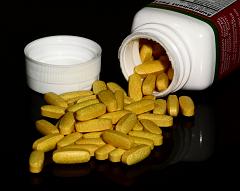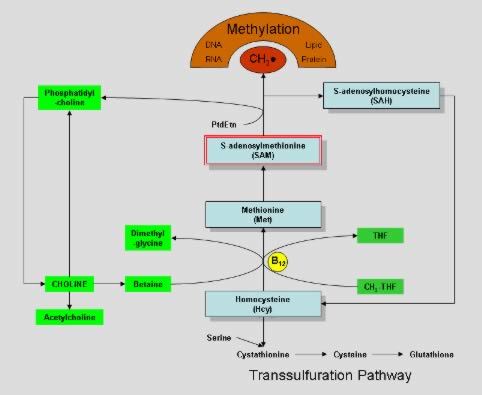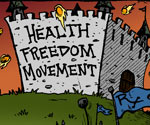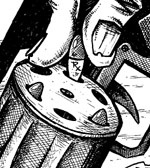Choline Bitartrate Benefits
| Share on Facebook | Share on Twitter | Share on Google+ |
Choline is an essential nutrient that would be classified as a B vitamin except that our bodies can make it in very small amounts. The body never makes as much choline as it needs, however, so it is necessary to get choline from food and supplements.

Choline and Vitamin B Supplement
Photo by Ragesoss
Every cell in the human body uses choline to build its outer membrane, which keeps it from being dissolved in the bloodstream.
Nerve tissue uses choline to make acetylcholine, which helps transmit electrical impulses from one neuron to another, and every cell uses choline to make messenger molecules such as platelet activating factor (PAF), which triggers clotting of blood and sneezing to get allergens out of airways, and sphingophosphorylcholine, which helps the immune system remove defective nerve tissue.
The body also uses choline to make phosphatidylcholine, which carries fats out of the liver.
Choline bitartrate is a form of choline that is readily absorbed by the body. It provides about 7 times as much choline as the more commonly used phosphatidylcholine supplements and up to 10 times as much choline as lecithin. You need 7 to 10 times as much of phosphatidylcholine and lecithin supplement as choline supplements to get the same nutritional benefit.
Unlike another readily absorbed form of choline, choline magnesium salicylate, choline bitartrate will not cause stomach upset, aspirin allergies, or "tingly" sensations, all of which are cause by the salicylate part of the product, not the choline itself.
Choline Interacts with Other Nutrients
For the body to use choline to make the phosphatidycholine that is essential for regulating cholesterol, it must also have "vitamin B6, vitamin B12, and folic acid. When folic acid supplies are low, the body can use choline as a substitute. And the enzymes that control these chemical reactions require magnesium.
A shortage of folic acid in the diet creates demand for more choline. And genetic variations in the use of folic acid may also create a demand for more choline.
How Much Choline Is Needed Every Day?
While the body can make choline from a compound called phosphatidylethanolamine and another compound called S-adenosylmethionine (or SAM-e), the body can never make as much choline as it needs from other substances. In 1998, the Institute of Medicine in the United States established an "Adequate Intake" standard for males and females at different stages of life.
| Adequate Intake of Choline (in mg per day) | ||
| Age | Males | Females |
| 0 to 6 months | 125 | 125 |
| 6 months to 1 year | 150 | 150 |
| 1 to 3 years | 200 | 200 |
| 4 to 8 years | 250 | 250 |
| 9 to 13 years | 375 | 375 |
| 14 to 18 years | 550 | 400 |
| 19 years and older | 550 | 425 |
| During Pregnancy | --- | 550 |
| While Breastfeeding | --- | 450 |
Which foods provide the most choline? In most diets, the biggest source of choline is egg yolks. Liver, and products made with liver, such as hot dogs and luncheon meat, contain more choline per serving, but also even more saturated fats.
There is a much smaller amount of choline in soy, but there is a lot of choline in salad dressings made with soy-based emulsifiers. The breakfast cereals Total and Kellogg's All-Bran contain very large amounts of added choline, much more than is found in eggs, liver, hot dogs, or sausages.
What Happens If You Don't Get Enough Choline?

How Choline Interacts with Other Nutrients
Diagram by Mihai Niculescu
As you can see from the chart, there are many factors besides how much choline is in the diet that determines whether the body makes choline-related chemicals it needs. Shortages of other nutrients can be as detrimental as shortages of choline.
The Adequate Intake standard is the amount of choline needed to avoid developing fatty liver. The liver sends fat to the tissues in the form of very-low density lipoprotein, or VLDL particles. VLDL is a "balloon" of phosphatidylcholine and protein, which is water-soluble, around cholesterol, which is not. When there is not enough choline in the diet, the body does not make enough phosphatidylcholine, and leaves fat in the liver.
Choline for Brain Health
Since the brain uses choline to make the neurotransmitter acetylcholine, high-dose phosphatidylcholine supplements have been tested as a treatment for Alzheimer's disease.
Choline for Weight Loss
Researchers at the University of Tennessee at Knoxville reporting their findings in the Journal of Nutrition in 2003 found that giving women a combination of choline and L-carnitine supplements helped them burn more fatter when they exercised. Giving women 940 mg of choline bitartrate a day, along with 648 mg of L-carnitine a day, resulted in 23 to 27% greater fat burning.
In practical terms, this is less than a pound a month (about 200 grams in most cases) for all but the most strenuous exercisers. Still, even fractions of pound or a few hundred grams of additional fat loss add up over a year or more of exercise. The researchers found that is was not necessary to take the supplements absolutely every day for fat burning to be accelerated. If you forget your supplements one day, you won't suddenly gain weight.
Studies of lab rats given a combination of choline bitartrate, L-carnitine, and caffeine, conducted by the same researchers at the University of Tennessee suggested even greater fat loss might be possible. However, the scientists conducting the experiments, Nobuko Hongu and Dileep S. Sachan, noted that the amount of caffeine the human volunteers in the second experiment ordinary consumed was roughly equivalent to the amount of caffeine they had given their lab rats in the first experiment. For that reason, Hogu and Sachan did not test giving additional caffeine along with choline bitartrate and L-carnitine to people on weight loss diets.
How much of these supplements are likely to help you if you exercise to lose weight?
- If you are a woman, take 1,000 mg of choline bitartrate and at least 500 mg of L-carnitine every day. Up to 1,000 mg of L-carnitine daily may be helpful.
- If you are a man, take 2,000 mg of choline bitartrate and at least 1,000 mg of L-carnitine every day. Up to 2,000 mg of L-carnitine daily may be helpful.
Choline and Cluster Headaches
Cluster headaches are nicknamed "suicide headaches" because the intense pain of the headache predisposes some to suicide.
They typically occur on just one side of the head, causing throbbing pain that may last for 15 minutes to 3 hours. The headache is accompanied by tears, runny nose, blushing, swelling, sweating, constriction of the pupil, or drooping of the eyelid on the same side of the face as the headache.
Cluster headaches are also known as "alarm clock headaches" because they tend to occur early in the morning and to recur on the same day of the month.
Taiwanese researchers have found that the ratio of choline to creatine in the brains of sufferers of cluster headaches is relatively low. This information does not translate well to a recommendation for supplements, although if you have cluster headaches and you take supplemental creatine, it would seem to be a very good idea to try supplemental choline (1,000 mg a day or less). Otherwise, supplemental choline is at least worth an experiment to see if it helps stop the frequency or severity of cluster headache attacks.
Choline and Migraine Headaches
Migraine headaches may or may not cause excruciating pain. Some people experience painful migraines after a prodrome of other symptoms.
Warning signs of a migraine attack include slurred speech, loss of sensation in the fingers or toes, severe mood swings, slurred speech, or visual changes that sometimes replace part or all of the field of vision with "static" or kaleidoscope-like images. Some people have the prodrome without the headache.

Some people experience visual or auditory hallucinations before migraines, without psychiatric illness. The prodrome of a migraine headache can cause transient global amnesia, in which the sufferer forgets everything about who they are, where they are, and the identity of family members, friends, and surroundings. Fortunately, transient global amnesia almost resolves itself as quickly as a migraine.
Drugs that convert choline into acetylcholine, such as carbachol, sometimes relieve the prodrome of migraine headaches (which would be something of considerable interest to you if your prodrome makes you go blind or causes hallucinations or triggers transient global amnesia).
Naturopaths take this as a cue to give migraine sufferers choline bitartrate to stop the symptoms of prodrome, but there has been no rigorous clinical testing of how much choline to take or whether it really helps.
If you have recurrent migraines, however, you probably actively seek any remedies you can, especially those that do not have side effects. Up to 1,000 mg of choline bitartrate a day may help. Give the product 30 days to see.
What Is a Normal Choline Bitartrate Dosage?
Take up to 1,500 mg of choline bitartrate daily. Taking more is not beneficial.
Are There Any Choline Bitartrate Side Effects?
The Institute of Medicine has established the upper limit of choline consumption for adults at 3,500 mg a day. Taking more than 7,500 mg a day may cause low blood pressure and a risk of fainting.
Taking more than 10,000 mg a day may cause fish odor syndrome (and you will absolutely know when you develop this symptom, as will everyone else around you), as well as vomiting, drooling, and increased perspiration.
One of the more difficult consultations with which I have ever been involved was the case of a woman who developed severe body odor despite good personal hygiene. Only when she mentioned "I forgot to tell you I take 20,000 mg of CDP-choline a day" was the source of the problem located. It took about a month for her body odor to go away. This does not happen if you take the recommended dosage.
Choline and Inositol
Combinations of choline and inositol are sometimes offered for nutritional support of Alzheimer's disease, Parkinson's disease, premenstrual disorder (PMS), depression, obsessive-compulsive disorder (OCD), bipolar disorder, polycystic ovarian syndrome (PCOS), and prediabetes.
Like choline, inositol is another not-quite-vitamin, once known as vitamin B8 before scientists discovered that the human body can make small amounts of inositol from glucose.
Inositol is found in fruit, legumes, and beans, especially in canteloupe, but most of the 1,000 mg of inositol in the daily diet is in the form of phytate, which has to be processed by symbiotic bacteria in the colon to release the inositol. Most of the health applications of inositol require dosages of 2,000 to 20,000 mg per day, although effects in PCOS may be observed after taking just 200 mg a day.

- One clinical trial found that taking 12,000 mg of inositol relieved symptoms of depression in people who were not receiving antidepressant medications, although another clinical trial found that inositol did not amplify the benefits of prescription antidepressants.
- Low doses (2,000 and then 4,000 mg) of inositol a day have been used to treat bipolar disorder with modest effects when the product was only used for 4 weeks. It may be necessary to use inositol for months or years to observe a full range of benefits. Some patients who are "allergic" to lithium may be able to use inositol instead of lithium. It is important not to use more than 4,000 mg a day to avoid "switching" which may induce a manic state. Do not take inositol for bipolar disorder without consulting your doctor.
- High doses of inositol, 12,000 mg a day, have been used to treat panic disorder. Inositol did not eliminate panic attacks, but made them less severe and less frequent. A follow-up study found inositol supplements to be as effective as treatment with the SSRI antidepressant Luvox (fluvoxamine). Do not take inositol for panic disorder without consulting your doctor.
- A daily dosage of 2,000 mg of inositol may help lower blood pressure, lower triglycerides, and support weight loss during diet to treat metabolic syndrome. Inositol seems to make dieting more effective for stopping prediabetes along with associated symptoms of the condition.
- Women who had polycystic ovarian syndrome (caused by excessive testosterone production in the ovaries) were given 100 mg of inositol twice a day for 14 weeks. The result was increased weight loss and greater frequency of ovulation.
Choline Bitartrate Toxicity
There are no safety issues with inositol, but it's important not to confuse inositol with inositol hexanicotinate, which is an artificial, extended-release from of the B vitamin niacin. Inositol hexanicotinate can and often does cause liver damage, but this does not occur from the use of inositol itself. Inositol is often combined with choline to keep it from being converted to compounds that do not support these conditions.
-
Skin CareMen Skin Care
-
Free ResourcesFree eBooks
-
The... patient should be made to understand that he or she must take charge of his own life. Don't take your body to the doctor as if he were a repair shop.Quentin Regestein
-
What We RecommendIf you do an analysis of the ingredients in a bottle of
 Total Balance and compare with other products you will find that it provides exceptional value for money…even against simple mass produced products with lower bottle costs.
Total Balance and compare with other products you will find that it provides exceptional value for money…even against simple mass produced products with lower bottle costs.
-



















